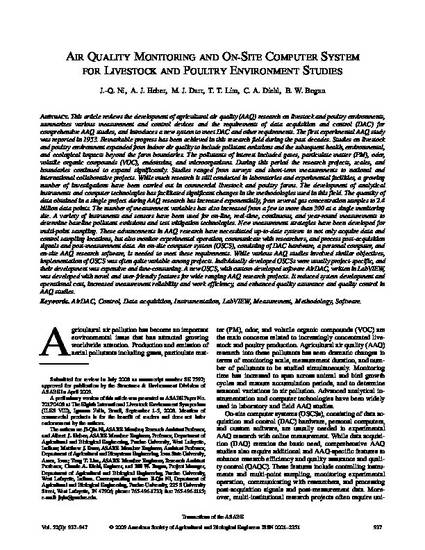
This article reviews the development of agricultural air quality (AAQ) research on livestock and poultry environments, summarizes various measurement and control devices and the requirements of data acquisition and control (DAC) for comprehensive AAQ studies, and introduces a new system to meet DAC and other requirements. The first experimental AAQ study was reported in 1953. Remarkable progress has been achieved in this research field during the past decades. Studies on livestock and poultry environment expanded from indoor air quality to include pollutant emissions and the subsequent health, environmental, and ecological impacts beyond the farm boundaries. The pollutants of interest included gases, particulate matter (PM), odor, volatile organic compounds (VOC), endotoxins, and microorganisms. During this period the research projects, scales, and boundaries continued to expand significantly. Studies ranged from surveys and short-term measurements to national and international collaborative projects. While much research is still conducted in laboratories and experimental facilities, a growing number of investigations have been carried out in commercial livestock and poultry farms. The development of analytical instruments and computer technologies has facilitated significant changes in the methodologies used in this field. The quantity of data obtained in a single project during AAQ research has increased exponentially, from several gas concentration samples to 2.4 billion data points. The number of measurement variables has also increased from a few to more than 300 at a single monitoring site. A variety of instruments and sensors have been used for on-line, real-time, continuous, and year-round measurements to determine baseline pollutant emissions and test mitigation technologies. New measurement strategies have been developed for multi-point sampling. These advancements in AAQ research have necessitated up-to-date systems to not only acquire data and control sampling locations, but also monitor experimental operation, communicate with researchers, and process post-acquisition signals and post-measurement data. An on-site computer system (OSCS), consisting of DAC hardware, a personal computer, and on-site AAQ research software, is needed to meet these requirements. While various AAQ studies involved similar objectives, implementation of OSCS was often quite variable among projects. Individually developed OSCSs were usually project-specific, and their development was expensive and time-consuming. A new OSCS, with custom-developed software AirDAC, written in LabVIEW, was developed with novel and user-friendly features for wide ranging AAQ research projects. It reduced system development and operational cost, increased measurement reliability and work efficiency, and enhanced quality assurance and quality control in AAQ studies.
Available at: http://works.bepress.com/matthew_darr/35/

This article is from Transactions of the ASABE 52, no. 3 (2009): 937–947.